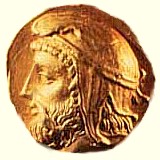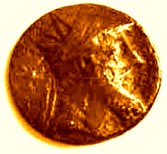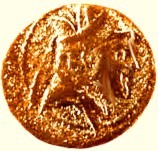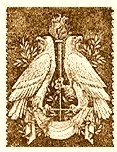
![]()
![]()
I N T H E P A R T H I A N C O U R T

'...Men rise and fall like the winter wheat... but Heroes never die...'
Written by Gevork Nazaryan
Prince Tigran, the son of King Tigran I of the Artaxiad Royal House, was born in 140 BC. In 112, Tigran was sent to Parthia, as a hostage or a "sign of friendship between the two peoples," after Tigran I's defeat in the Parthian campaign. This was a common practice at the time, the Parthians knew that King Tigran I would in all probability not risk his sons life -- the heir apparent to the throne --, and once again initiate hostilities against Parthia as long as the Prince remains in their royal court. It is important to note here that the Parthians stood very close to Armenia, many of the Parthian noble houses had their branches in Armenia. Tigran was a member of the Parthian court and as the Prince of his Kingdom was in a sense a "good will ambassador" to Parthia. During his stay in that country, the young prince learned many things from the Parthians who were renowned for their warrior ethos and keen leadership. Tigran learned the fine art of diplomacy and as well as waging military campaigns. The Parthian army was trained to fight on horsebacks, their famous style of warfare that desolated Roman legions was known as the "Parthian shot." The Parthian cavalry, would first engage the enemy and would pretend to retreat in an unorganized fashion, the deceived Romans would quickly brake in their flanks and pursue the Parthians. The Parthians, while "retreating," would use their distinguished archery skills and shoot down the pursuing enemy. In such battles, the

OBVERSE SIDE OF THE GOLD COIN [362 BC] OF KING
TIRIBASES [ARMAN TIR/TYR TEACHER/PHILOSOPHER GOD-MAN OF WISDOM
PARALLEL OF THOTH/HERMES]
OF THE OR[I]ONTID [ERVADUNI] HOUSE
THAT PRECEDED THE ARTAXIAD DYNASTY.
NOTE THE MITHRAIC CAP WITH THE
RING/HALO AND THE EXTENDING TASSELS OF GLORY/POWER.

OBVERSE SIDE OF THE COIN OF KING XERXES [190-170 BC]
OF THE OR[I]ONTID [ERVANDUNI] HOUSE
RULING THROUGHOUT MUCH OF LESSER ARMENIA [ARMENIA MINOR --
ENCOMPASSING INITIALLY SOPHENE [TSOPK] PROVINCE ON THE RIGHT BANKS OF
THE SACRED EUPHRATES RIVER -- DURING THE REIGN OF TIGRAN THE GREAT
SOPHENE WAS INCORPORATED INTO GREATER ARMENIA OR ARMENIA MAJOR]
VAST LANDS ON THE LEFT BANKS OF THE EUPHRATES EXTENDING TO BLACK SEA
PONTIC KINGDOM INCLUDING PARTS OF COMMAGENE AND CAPPADOCIA.

OBVERSE SIDE OF THE COIN OF KING ABDISSARES [210-190 BC]
OF THE OR[I]ONTID [ERVANDUNI] HOUSE OF ARMENIA MINOR-
COMMAGENE.
Romans would loose thousands of men before finally seeing the horrible death toll and stopping the disastrous chase. The Roman legions had no chance in even coming close to the lightening fast Parthian cavalry squads. Such tactics would be adopted by Tigran and the Armenian cavalry, that were also effectively used against the Roman invaders. The Parthians were considered allies by most of Armenians at this time [especially in Greater Armenia -- Lesser Armenia tended to be more pro-Roman]. Many Parthian noble houses had branched out and established themselves in Armenia. Houses such as Kamsarakan, Mamikonean, Pahlavuni and the biggest and powerful Royal Houses of Parthia, the Arsacids who ruled Iran from the late third century BC until the first half of the third century AD.. The Arsacid Royal House of Armenia was formally established in the year 66 A.D. with the recognition by the Emperor Nero of King Trdat I [Tiridates] Aršakuni, as the sovereign monarch of the Kingdom.
